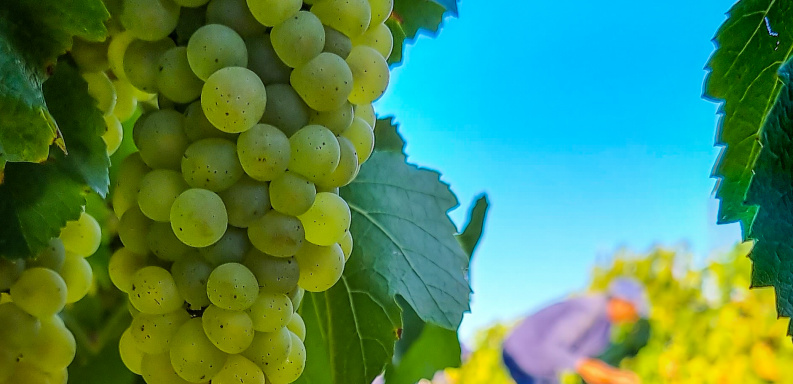The surprising malleability of Chardonnay
By Jamie Goode | 14th April 2023
Chardonnay. It was the grape that turned Britain onto white wine in the 1990s, and most of it came from Australia. Back in the 1970s and 1980s the supermarket wine shelves looked very different to how they are today. The white wine sections were (apparently, I wasn’t drinking then!) largely populated by semi-sweet German wines and French classics like Muscadet and Chablis. But then along came Australian Chardonnay, tasting of sunshine, with lots of body and weight, and spicy vanilla notes from barrel fermentation, and everything changed. Within a few years, the name ‘Chardonnay’ became synonymous for dry white wine. I started drinking wine in the mid-1990s, and I remember this time well.
At the time, Chardonnay was quite monolithic. It’s a variety that can tend to fatness when grown in warm climates, and the most popular Australian examples were big, broad and rich, with ripe peachy fruit supplemented with liberal dollops of oak, contributing vanilla, bread and spice notes. I used to love these wines, but over time people fell out of love with the richness of Chardonnay and it was time for the chiselled, bright, highly aromatic Sauvignon Blanc to have its time in the spotlight. Now if you ask for a dry white wine you are more likely to get a zippy Sauvignon than you are a rich Chardonnay.

But to characterize all Chardonnay by the popular rich styles from Australia and California would be a mistake, because this is actually one of the most highly malleable grape varieties out there. You can grow it in warm climates, and also in cooler ones. You can pick it early, or let it get super-ripe on the vine. And winemakers love it because it offers them so many choices. The classic way to make it is to barrel ferment it in small oak, where the flavours of Chardonnay marry well with those coming from the barrel. This is how it is usually made in its homeland, Burgundy. But in a northern outpost of Burgundy one of the most famous expressions of Chardonnay is made without any oak influence at all: Chablis. And then we have the vital role Chardonnay plays as the main white grape variety in Champagne. I can’t think of any other grape variety that is so versatile.
And Chardonnay is doing really well in South Africa, although sometimes it lives a bit in the shadow of Chenin Blanc (the most widely planted grape variety here) and even sometimes Sauvignon Blanc (which does surprisingly well and is very popular). South Africa’s first varietal Chardonnay was made in 1978 by Simonsig, from heavily virused vines. The shortage of good planting material in the country led a bunch of winemakers who wanted to work with this variety to form an unofficial importing ring. Led by Danie De Wet of De Wetshof, now one of the leading wineries working with this variety, the group successfully smuggled in Chardonnay vines in the late 1970s and shared them around.
They were frustrated because the KWV, the organization that held the South African industry in an iron grip, was not importing any clean planting material. This smuggling was to become an organized operation that took place until the early 1980s. Armed with decent virus-free vines, winemakers in South Africa quickly took to Chardonnay, which now thrives in many of the Cape’s wine regions.
Stellenbosch is probably the hot spot for the richer style of barrel-fermented Chardonnay, and these can be very good, combining ripe fruit with well-managed oak. Capensis, a relative newcomer, is one of the standout producers here, along with the likes of Rustenberg, Radford Dale and Oldenberg, but there are lots of really good examples.
Elgin is perhaps the leading destination for Chardonnay, and each year hosts a festival around this grape variety. Here, the emphasis is more on focused, slightly leaner wines, with the famously cool climate of the region keeping the fruit flavours chiselled sharp and more in the citrus direction. Look out for names like Sutherland (from Thelema), Boschendal (Elgin designated wines), Almenkerk and Kershaw.
Likewise, Hemel-en-Aarde’s cool climate has made this a significant region for Chardonnay, and a good proportion of the top examples from South Africa have their roots in this beautiful region. Stand outs include Crystallum, Restless River, Creation and Newton Johnson.
And we must be careful not to forget Robertson. This is a warm region, but perhaps not as warm as the data seem to indicate, because it makes some stunning Chardonnay with freshness and complexity. The limestone influence in the soils probably helps here. The producer leading the pack is the aforementioned De Wetshof, involved in bringing good Chardonnay vine material into the country, and now making a range of superb ageworthy Chardonnays.
This leads us nicely to Cap Classique, where Chardonnay is arguably the key grape. These are South Africa’s traditional-method sparkling wines and this is a growing (and exciting) category. Robertson has proven to be a key region for Cap Classique, and the country’s leading proponent, Graham Beck, are based there. It’s testimony to the versatility of Chardonnay that it can make the sort of lean, high-acid low-alcohol base wines needed for top quality sparkling wine at the same time as making richer, fuller flavour wines that are completely different in style, but equally compelling.
